Special Senses 2 – Olfaction and Gustation
1/54
There's no tags or description
Looks like no tags are added yet.
Name | Mastery | Learn | Test | Matching | Spaced |
|---|
No study sessions yet.
55 Terms
Taste and smell are referred to as the ________ senses because the involve the detection and interpretation of chemicals in the external environment
chemical
Taste and smell work together to create the perception of _____.
flavor (although olfaction is the dominant component)
taste and smell are essential to the physiology of lower mammals. how?
i.e. olfactory stimuli regulate reproductive physiology, food intake, and social behavior. Taste stimuli regulate ingestion or rejection of food
why is it challenging to understand chemical senses?
stimuli are diverse group of volatile/soluble chemicals
olfactory system can discriminate between millions of odorants and can identify them upon re-exposure
gustation has similar, but smaller complexity
ability to maintain sensory capacity persists even though cells containing sensory receptors turn over hundreds of times over your life
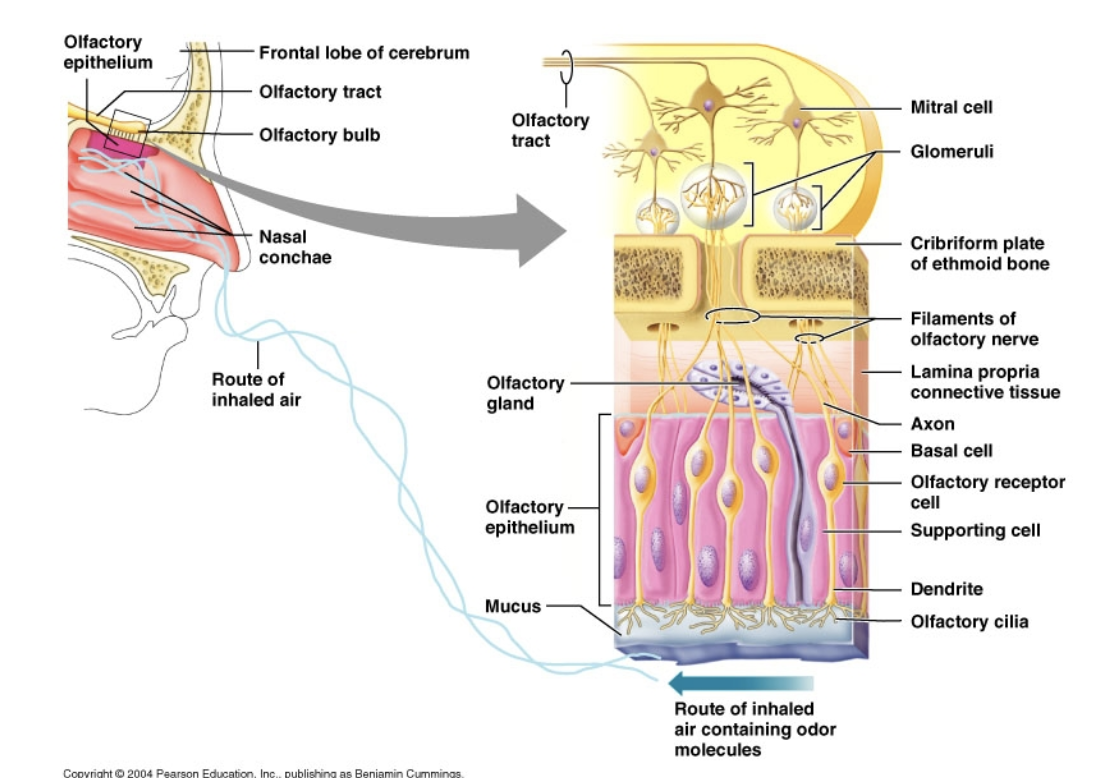
describe the peripheral olfactory apparatus (pathway).
chemicals from air get trapped in olfactory epithelium mucus layer
interact with cilia to activate olfactory receptor cells
axons pass through cribiform plate and synapse in olfactory bulb
neurotransmitters released into glomeruli and synapse onto mitral cells
olfactory cues travel to brain via olfactory tract
which part of the olfactory apparatus anatomy contains receptor cells which are bona fide neurons in the periphery? (true neurons that get replaced over life)
nasal epithelium
where is the nasal epithelium located?
Lies in the posterodorsal portion of the nasal cavity below the cribiform plate on both the nasal septum and lateral wall
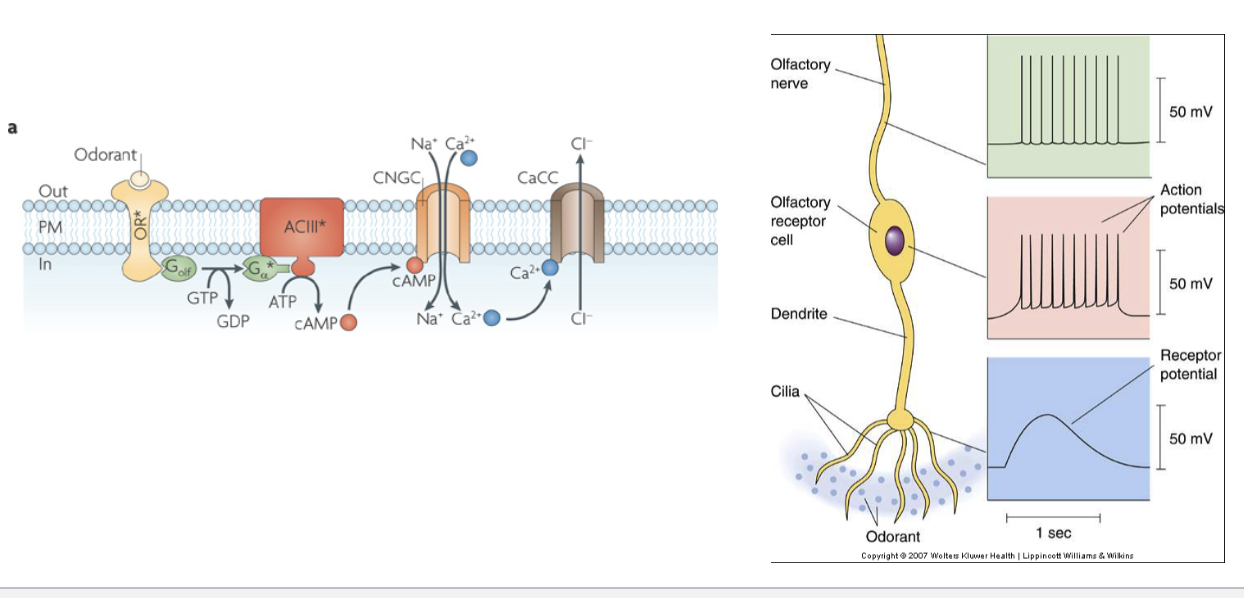
what is the series of events that occur during stimulus trandsuction in olfactory receptors?
1. An odorant is delivered to the epithelium in the air
2. The odorant diffuses through the mucus to reach the ORC cilia
3. The odorant interacts with an odorant receptor
4. Binding to the receptor generates a depolarizing generator potential in the ORC
5. The generator potential is passively conducted and elicits an action potential.
what type of receptors are olfactory receptors?
G-protein coupled receptors (GPCRs)
there are over 1000 GPCRs genes (largest gene family in animal kingdom)
how many members of the OR gene family is expressed by a single olfactory neuron?
It is likely that a single olfactory neuron expresses only 1 member of the OR gene family
how many different types of human olfactor receptors/ORCs are there?
~300
Neurons that express a particular OR are limited to where?
a particular zone of the epithelium
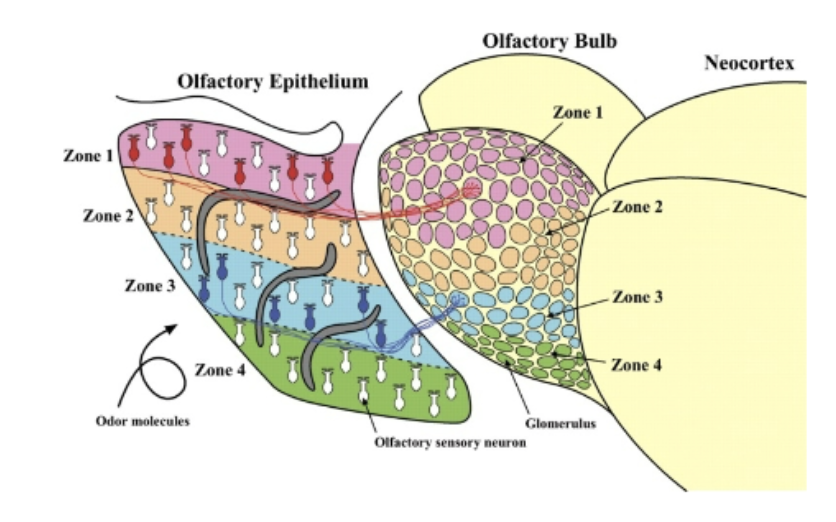
how do different odorants with similar chemical structure smell different to us?
different combinations of receptors being activated can cause us to perceive different smells
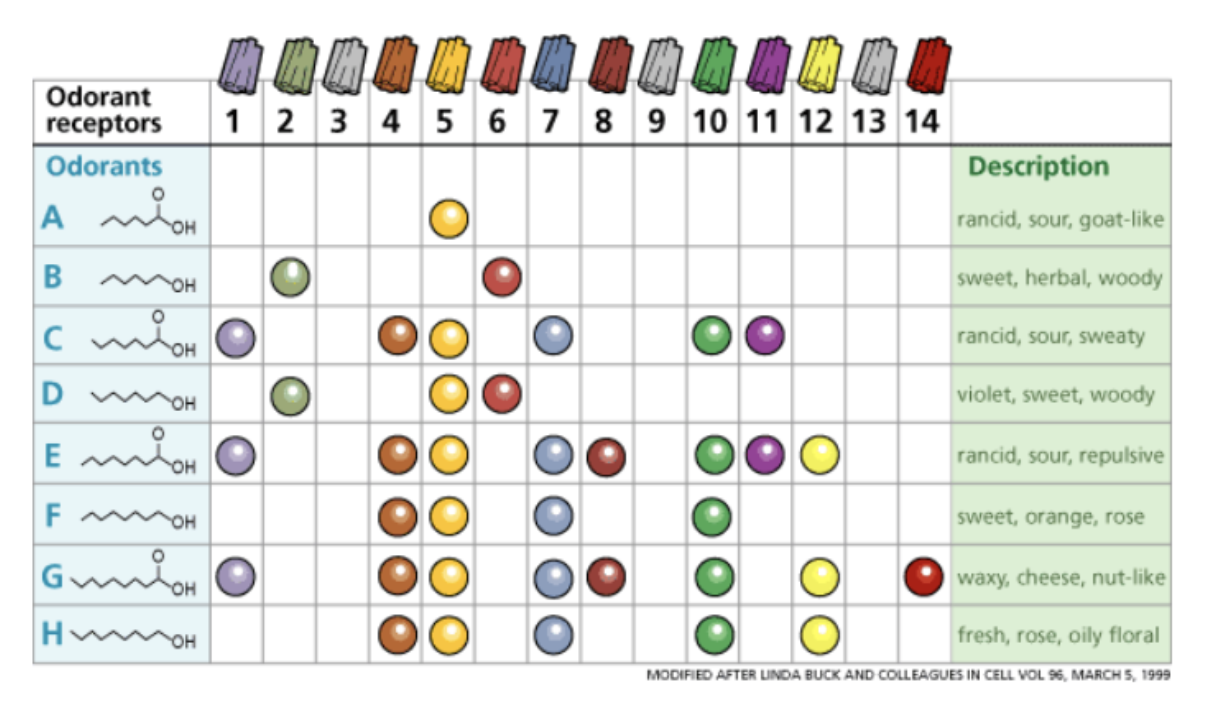
what is the most rostral part of the CNS and is highly evolutionarily conserved from fish to man?
olfactory bulb
what is the fundamental unit of physiological organization in the olfactory bulb?
glomeruli
what is a glomeruli?
fundamental unit of physiological organization in the olfactory bulb
cells cluster around pockets of neuropil known as glomeruli
how is the olfactory bulb organized?
tubular
cells/neuropils arranged in concentric rings like onion layers
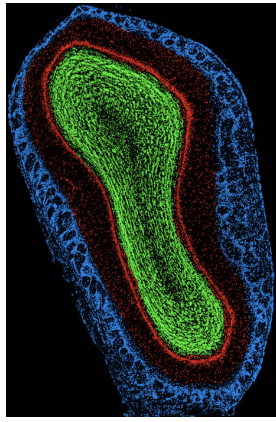
what are the two organizational characteristics of the olfactory bulb?
1. Quadrant to quadrant organization
2. Within a quadrant, all of the neurons that express the same OR converge on a single pair of glomeruli
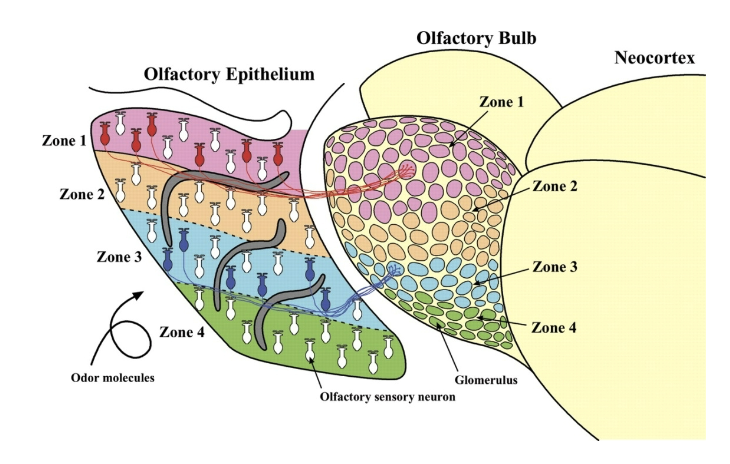
Downstream of the olfactory bulb is the ______, which is organized in some ways like visual cortex
olfactory cortex

G = glomeruli
M = mitral cells
what is the basic sensory cell of gustation?
taste bud
taste information flows from the taste buds to…?
medulla
what are the primary tastes?
sweet
sour
salty
bitter
umami
the 5 primary tastes correspond to 5 prototypical flavor stimuli. what are they?
• NaCl (salty)
• Sucrose (sweet)
• HCl (sour)
• Quinine (bitter)
• MSG (umami)
taste buds are a collection of what kind of cells? and how many cells per bud?
sensory and supportive cells (50-100 cells/bud)
where are taste buds embedded?
in stratified squamous epitherlial lining of oral cavity and upper pharynx
what are type I cells in taste buds?
type of glial (non-neuronal) cell
what are type II cells in taste buds?
heterogenous and can transduce sweet, bitter, or umami
what are type III cells in taste buds?
transduce sour and salty
describe the anatomy of a taste bud
microvilli of apical membrane of receptor cells extend through taste pore
axons penetrate basal laminae and innervate receptor cells
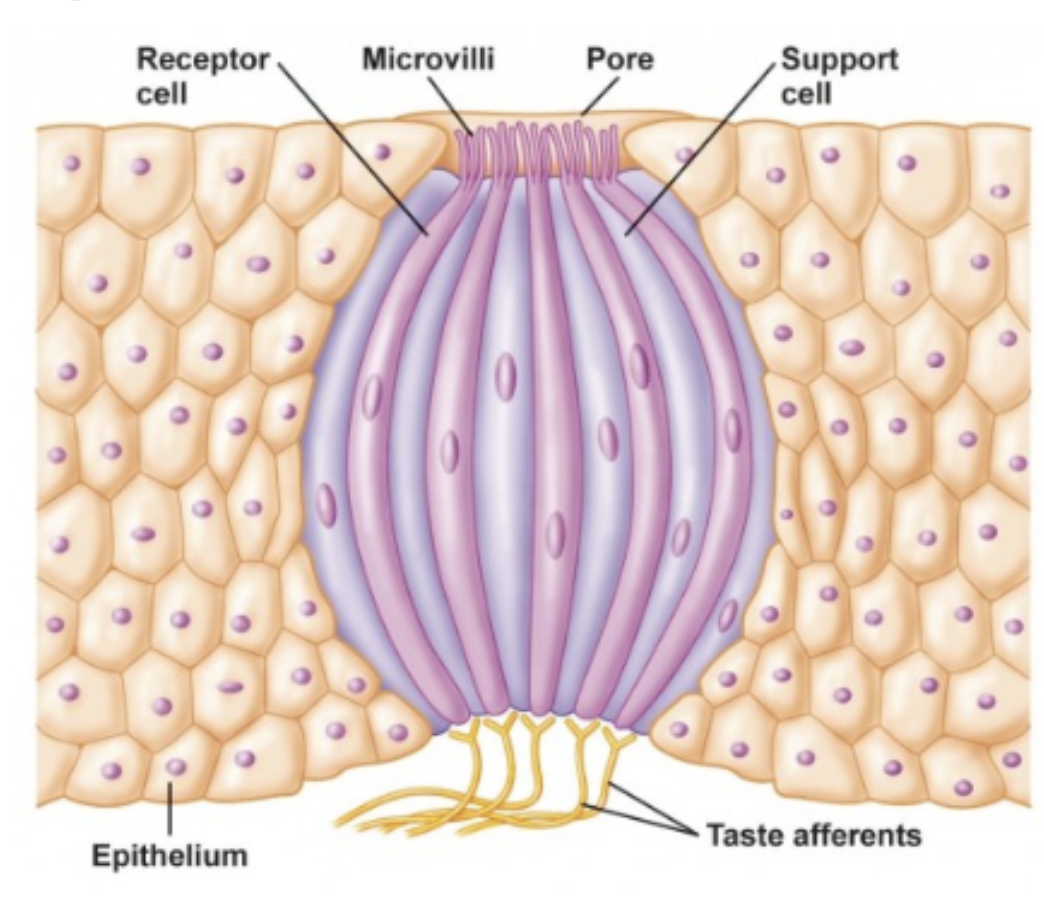
Taste buds are limited to specialized protrusions known as ________
papillae
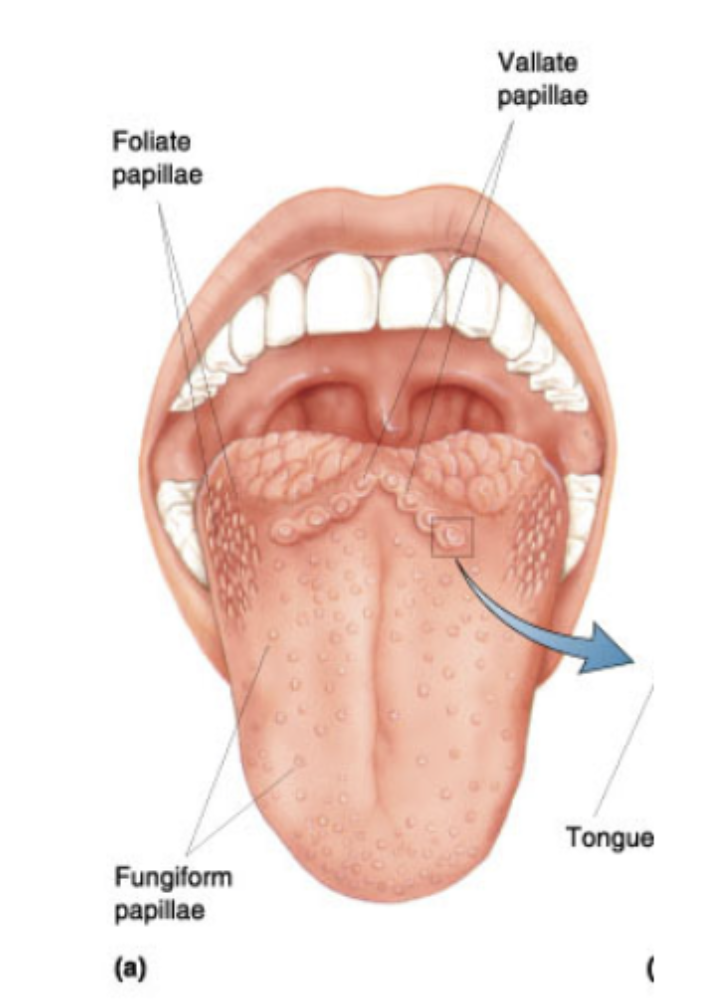
what type of papillae are large and visible to the naked eye?
vallate (or circumballate)
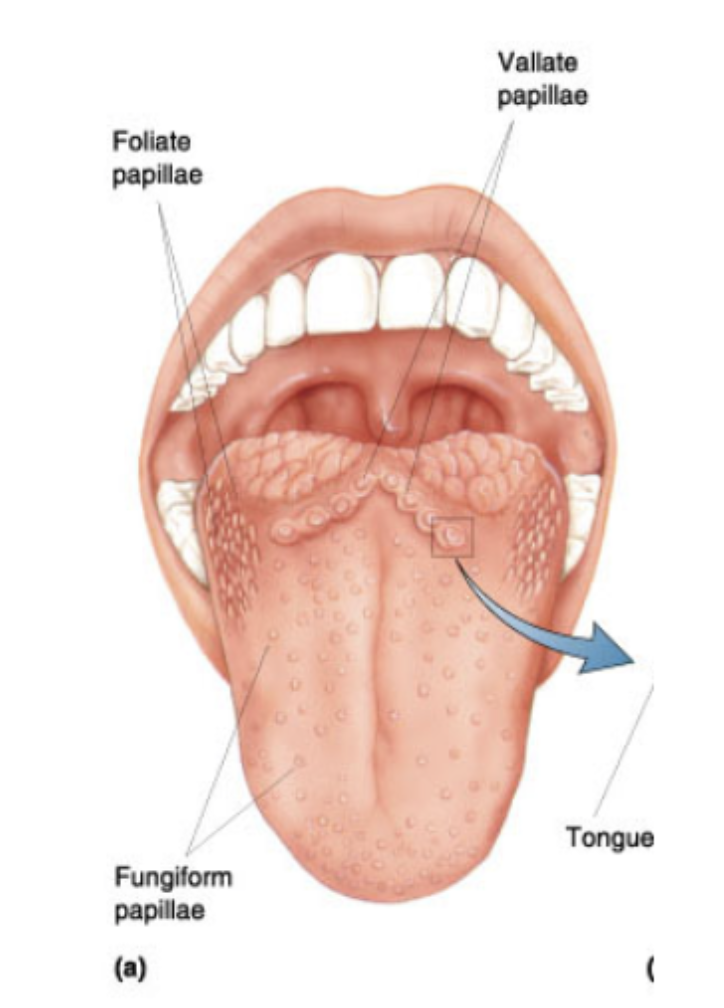
what type of papillae are found on the dorsolateral part of the tongue and are much smaller than circumvallate?
foliate papillae
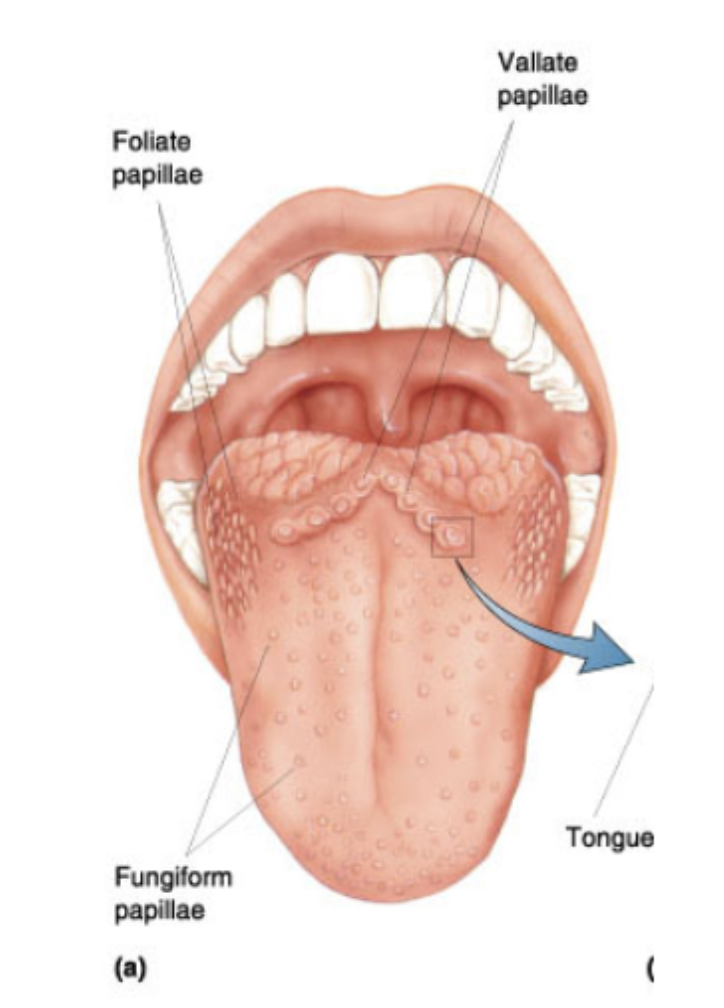
what type of papillae are mushroom like and found on anterior 2/3 of the tongue?
fungiform papillae
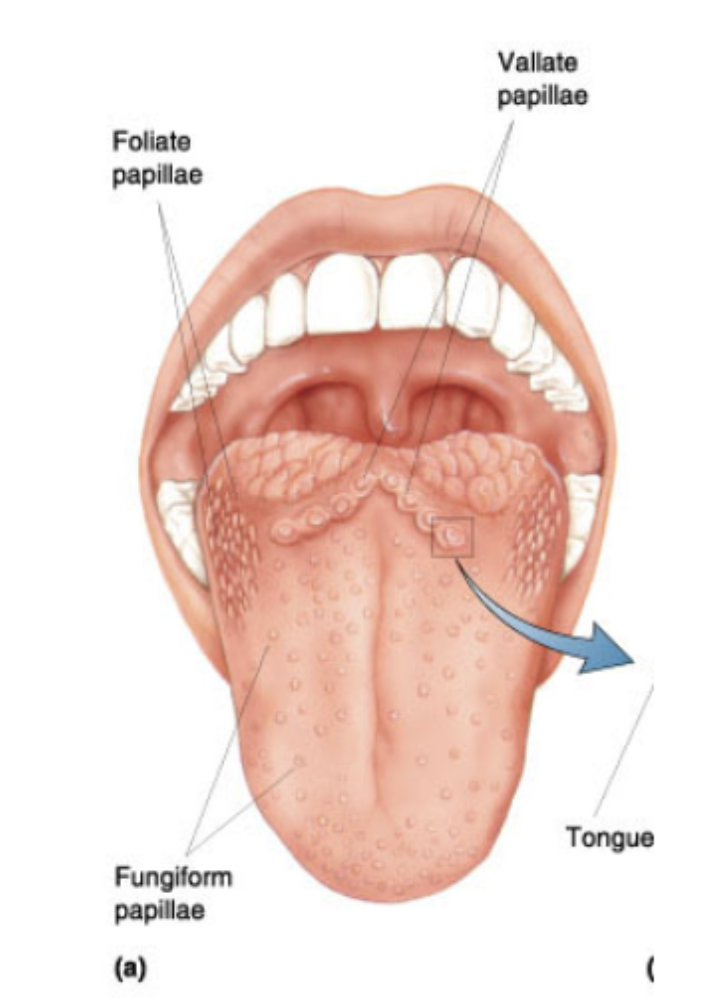
besides the tongue, taste buds can also be found where?
hard palate, soft palate, epiglottis
taste buds are innervated by which cranial nerves?
CN VII (facial), IX (glossopharyngeal), and X (vagus)
a single gustatory axon will innervate how many taste buds?
2-10 taste buds
a single gustatory axon receives input from how many receptor cells/buds?
~5 (receives broad sensory inputs across flavors)
describe how CN VII innervates taste buds.
chorda tympani n. to the tongue
greater petrosal n. to the palate
describe how CN IX innervates taste buds.
to vallate papillae and posterior 1/3 of tongue
describe how CN X innervates taste buds.
via superior laryngeal n. to epiglottis and laryngeal aditus
Gustatory axons enter the medulla and innervate cells in the rostral and lateral part of the…?
Nucleus of the Solitary Tract (NST; aka the gustatory nucleus)
The NST is laid out in a rough linguotopic map. From here gustatory information flows to 3 other locations. What are they?
medullary reticular formation
reflexes related to ingestion/rejection of food
parabrachial nucleus (pontine taste relay area)
then, amygdala and hypothalamus
motivation and appetitive aspects of taste
parvicellular part of ventral posterior medial nucleus of thalamus
then, to taste cortex
describe the mechanism of transduction for salt receptors?
activates passive Na conductance in the apical membrane resulting in depolarization in the presence of increasing concentrations of NaCl.
Blockable by the channel blocker, amiloride (Type III cells)
describe the mechanism of transduction for sour receptors?
H+ blocks a voltage dependent K+ channel on the apical membrane via a Ca2+ channel called a transient receptor potential (TRP) channel. (Type III cells)
describe the mechanism of transduction for sweet receptors?
specific membrane receptors of the T1R family of GPCRs. (Type II cells)
describe the mechanism of transduction for bitter receptors?
specific membrane receptors of the T2R family of GPCRs. (Type II cells)
describe the mechanism of transduction for umami receptors?
Possibly multiple receptors. (Type II cells)
A single receptor cell will respond primarily to # taste modality, but will also respond to a lesser degree to other taste stimuli
1
Each chorda tympani fiber gets inputs from ≈ # receptor cells.
50
Each receptor cell shows responses to more than 1 type of stimulus
how do we discriminate taste?
best current hypothesis = blend of labeled-line and mixed-fiber concepts
labeled-lines → discrimination of major categories of stimuli
mixed-fibers → shape interpretation of those signals
You would assume that each CT axon would be broadly tuned to multiple tastes. In reality, each CT axon responds to…?
primarily one of the main tastes. They do respond to some degree to multiple tastes, but they show a great preference for one.